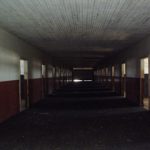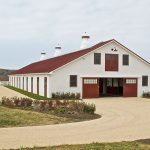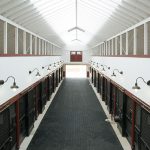“I had one owner complain about how cold her barn was in winter. She said the grooms complained endlessly. My answer was to issue the grooms long underwear because the barn is designed primarily for the health of the animal, not the comfort of the human.” – John Blackburn
If there was ever an understatement made, it was in the first line of “Heated Barns and Horses: Special Considerations Needed.” The article written by Oklahoma State University Cooperative Extension equine specialist, Dave Freeman, PhD and published by TheHorse.com in 2011 begins, “Horse owners who use heated barns to keep water from freezing and to protect horses from frigid temperatures during winter should remember supplement heat can cause problems if used incorrectly.”
For me, the most important considerationis the unhealthy and potentially hazardous effect of added heat on the “naturalness” of a barn’s environment. Even in the winter, when temperatures may be below freezing, the barn should duplicate the choices a horse would make if it were living in the wild. For example, in winter if a horse wants to warm up it may choose to move into the sun. If it wants to get away from the cold it will run behind a hill or some natural obstruction. The options a horse has to control its environment are eliminated in a heated barn yielding a less natural experience and potentially creating an unhealthy and high-risk environment. One of those risks is the restriction on natural ventilation and the need to rid the barn of humidity that can cause harmful bacteria. An owner may attempt to close up the barn to “save” on the cost of the heat but at the same time restrict natural ventilation. I am not opposed to heating human spaces, but I am concerned when heat is introduced to the stable area. In my projects, we have provided heat to the floor of the aisle in extremely cold climates but we do not close off the natural vertical flow of natural ventilation through the stable area.
Ventilation is important regardless of the temperature outside or inside the barn. As an equestrian designer who’s primary focus is healthy stables, I completely agree with Dr. Freeman on this point. I feel every barn should ventilate all winter no matter where it is located or what the temperature is outside might be. As always, as much natural light as possible should be brought into the barn as possible. We install continuous ridge skylights whenever possible in our designs that provide a totally naturally light interior all day long, which is, also most close to what the horse encounters in nature. Our renovation of the thoroughbred broodmare barns at Sagamore illustrates my point. See photos below.
I don’t want to imply that a healthy stable design will solve all your winter heat or equine health concerns but that it is a very important part.
Barns without ventilation are more prone to high humidity, which creates ideal incubating conditions for disease causing pathogens. Dr. Freeman suggest turning down the heat to get rid of excess humidity but I would take that suggestion further by not introducing heat into stalls area at all. The stall area should stay within 8 to 10 degrees of the exterior temperatures. This allows horses to adapt more easily when moving from stalls to paddocks in the winter months. Horse blankets and proper adjustments of feed for winter conditioning are other important considerations for helping your horse adjust to cold weather. Also heat lamps in a stall for a young or feeble horse should also be considered before enclosing and heating the entire barn for this purpose.
I hope you read the article, Heated Barns and Horses: Special Considerations Needed. It provides some great advice. Also, if I may, read my new book, Healthy Stables by Design. My focus of the book is you illustrate how one can create a healthy and safe environment for the horse hat doesn’t have to be expensive (though many are and that it primarily due to human or owner desires) and it can be accomplished in almost any environment with good design principles. A successful equestrian design is one that incorporates and balances three essential needs; the needs of the owners, demands of the site and the health and safety of the horse without sacrificing the health of the horse. That remains paramount.




